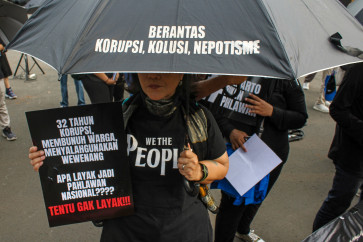Cover Story: 'Calon Arang'
âAn ancient legend has bec ome a perm anent fi xture in modern BaliâThe enraged men encircled the long-haired supernatural creature, who embraced the imminent clash with a terrifying scream
Change text size
Gift Premium Articles
to Anyone

'An ancient legend has bec ome a perm anent fi xture in modern Bali'
The enraged men encircled the long-haired supernatural creature, who embraced the imminent clash with a terrifying scream. Each man wielded a short kris, or wavy dagger, the Balinese warriors' preferred weapon for close quarters combat. In unison they raised their daggers into the air and, letting out a battle cry, hurled themselves onto the creature.
It was an assault that no mortal could escape. But the creature ' a magical transformation of a vengeful woman scorned by her own society ' was no ordinary mortal. For decades she had committed herself to the esoteric teachings of Durga, the goddess of death and the deity often associated with black magic.
Steel weapons forged by men were no match for the layers of invisible shields made of ancient mantras that protected her body. As she waved the white cloth in her hand, an invisible force sent the men staggering away. They twisted, writhed and screamed before turning the daggers unto themselves; they were all falling under her spell.
The spectators gasped out of fear and fascination ' fearful of the possible victory of such a terrifying figure and fascinated by the fact that a woman could possess such tremendous power that a mighty king and his army had to flee.
This scene is the climax of Calon Arang, a Balinese sacred dance-drama usually performed during major temple festivals. Its abridged, secular version used to be one of the most popular shows for visiting tourists. That was before banana boats and feeding the elephants became the visitors' preferred post-breakfast ritual.
The dance-drama is based on the legend of a widow of the same name who lived during the reign of Airlangga in the 11th century Kahuripan kingdom in East Java. Airlangga was the oldest son of King Udayana and Queen Mahendradata, the famed rulers of ancient Bali, which is probably one of the reasons why the legend is so popular here.
Calon Arang resided in Girah village and was feared by the local populace, who believed that she was an adept practitioner of black magic. They attributed the plagues that often destroyed their crops to her magic and the youngsters shunned her beautiful daughter Ratna Manggali.
It was said that when Calon Arang learned about the ill-treatment experienced by her daughter, she unleashed an epidemic so powerful that it nearly decimated the human population of Kahuripan. Airlangga sent his fiercest generals to confront Calon Arang but they all met their demise at the hands of the widow and a handful of her exclusively female followers.
Airlangga later sought the help of Mpu Bharadah, a powerful priest, who sent his disciple Mpu Bahula to win Ratna Manggali's heart. Bahula eventually married Ratna Manggali, an act that provided him with access to Calon Arang's books of spells. He stole the books and gave them to Bharadah. Using the knowledge he gained from the books, Bharadah defeated Calon Arang in a battle.
The legend has all the required ingredients ' palace intrigue, a lover with an ulterior motive, and an imposing matriarch with a taste for social rebellion ' for a good soap. But that is not the main reason why the Balinese adore Calon Arang so much. They love it because it focuses on black magic.


Locally known as pengleyakan or pengiwa, black magic is not a thing of the past. Ask any Balinese, even those who have travelled to Paris on vacation or were educated in Melbourne, whether they or their family have had any experience with black magic and the chances are that they will say yes. It may be a case of an aunt being possessed with demonic spirits sent by someone, a father being poisoned with a traditional potion, a niece being enchanted by her disappointed lover, or a grandfather who was killed in a night 'battle' against a black magic practitioner.
'The fear [of black magic] is still there and it speaks volumes about the mental state of our community. You can call it irrational or whatever, but for these people the fear is real and the actions they pursue to mitigate that fear ' organizing ceremonies, buying amulets, learning esoteric white magic ' are real too,' poetess Mas Ruscitadewi said.
The resurgence of Calon Arang in the last ten years ' rarely a major temple ceremony goes by without the Calon Arang dance-drama or the Calon Arang puppet show ' is clearly a testament that most Balinese are still fascinated by, if not terrified of, black magic.
'To some extent, the resurgence provides us with an avenue to correct the public's misconceptions about pengeleyakan. It is a body of knowledge and it is not malicious in itself. It is the same with a knife. One man can use the knife to murder, another can use it to prepare food. It is the man who is wicked or good. Knowledge is neutral,' martial arts guru Ngurah Harta said.
Harta is one among a few Balinese who publicly defend pengeleyakan as a valid body of knowledge, as well as part of the island's cultural heritage. A leader at Sandhi Murti, a martial arts school with a 26,000 strong membership, Harta is currently restoring Calon Arang's original house in Girah.
The resurgence has also affected the island's intellectuals, with prominent author Cok Sawitri announcing that Calon Arang was a victimized feminist in a patriarchal society in her novel Janda dari Jirah (The Widow from Jirah).
'She was scorned, isolated, assaulted and destroyed simply because she was different. She was a strong-willed woman who devoted herself to a certain spiritual path, which happened to be different from the one professed by the king.'
Calon Arang was, and still is, a controversial figure. Fortunately, in modern Bali it is okay to be mesmerized or frightened by her persona.









